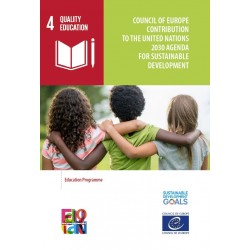
Voices of Youth is a dedicated platform for young advocates to offer inspiring and original insights on issues that matter to them. We also team up with United Nations partners to engage youth through the award-winning Wild for Life campaign to curtail illegal trade in wildlife.

This is why we engage girls and boys to elevate their voices on environmental issues. While these issues are not central to UNICEF’s programmes, children and youth have expressed in no uncertain terms that protecting and preserving all living things on the planet is important to the well-being of people, prosperity and peace. UNICEF recognizes and encourages the leadership that children and youth are taking to raise awareness and end harm to wildlife and the environment. Land degradation, together with forest, species and biodiversity loss, is interconnected with climate change and poses a serious threat to a child’s ability to survive, grow and thrive. Protect, restore and promote sustainable use of terrestrial ecosystems sustainably manage forests combat desertification halt and reverse land degradation and halt biodiversity loss. We do this by ensuring access to clean water, sanitation and hygiene services. UNICEF supports Small Island Developing States and other communities impacted by rising sea levels, higher levels of drought and water stress, heavier rainfall and flooding, and the melting of snow, glacier and sea ice. This is already happening in low-lying coastal areas and Small Island Developing States ─ home to roughly 25 per cent of the world’s population. In times of drought or flood, in areas where the sea level has risen or ice and snow have unseasonably melted, children are being cut off from the water they rely on. Rising sea levels can lead to saltwater infiltrating freshwater sources, rendering the water undrinkable. For many children, a change in climate is felt through a change in water. The impacts of climate change are being felt around the world. Today, 530 million children live in extremely high flood occurrence zones, and 1 in 4 children will live in areas of extreme water stress by 2040. Child labour is both a cause and consequence of poverty, reinforcing social inequality and discrimination. UNICEF works worldwide to prevent and respond to child labour, addressing the impact of supply chains and business practices on children, and providing children with rehabilitation and reintegration services. UNICEF also works with United Nations partners to promote youth skills and employment, including through Generation Unlimited, a partnership that aims to ensure that every young person is in some form of school, learning, training or employment by 2030.Ĭonserve and sustainably use the oceans, seas and marine resources for sustainable development. Meanwhile, nearly 1 in 10 children worldwide are subjected to child labour, almost half of whom are in hazardous forms of work. Without urgent investment in education and skills training, the rapidly growing population of young people – expected to reach nearly 2 billion by 2030 – will be largely unprepared for the workforce.

Today’s global youth unemployment rate is 13 per cent – three times higher than the adult rate.
#United nations agenda 2030 full#
Promote inclusive and sustainable economic growth, full and productive employment, and decent work for all.


 0 kommentar(er)
0 kommentar(er)
